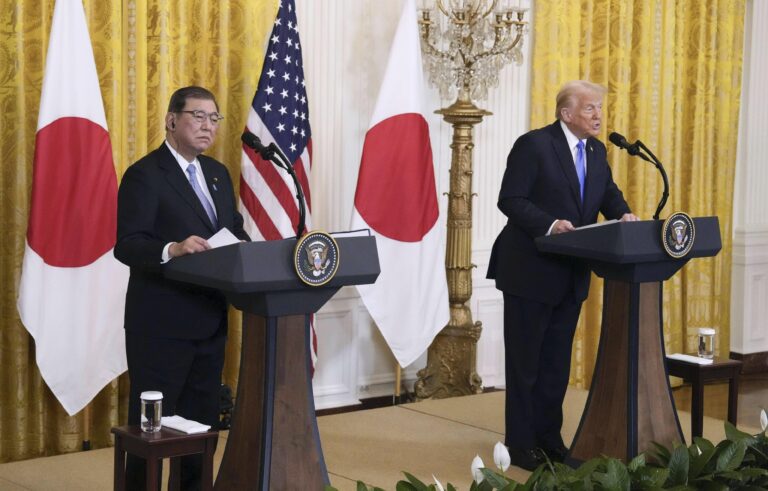President Donald Trump has announced the implementation of a 25 percent tariff on all imports from Japan and South Korea, with the new trade measures set to begin on August 1.
The announcement was made via his Truth Social platform, where he shared copies of formal letters addressed to the leaders of both nations.
This move marks a renewed push by Trump to intensify trade pressure on United States allies, following a temporary pause in his tariff escalation plans earlier this year.
Newsweek reached out to the Japanese and South Korean Embassies in the U.S. for comment via email on Monday afternoon.

Associated Press
Why It Matters
Trump has been signaling for some time that he intends to end ongoing trade negotiations and formally notify countries of new tariff rates.
Speaking to reporters on Friday, the president said, “I signed some letters, and they’ll go out on Monday, probably 12.”
The letters, printed on official White House stationery, bear Trump’s signature style, including bold capitalization and emphatic phrasing. In messages addressed to the leaders of South Korea and Japan, he wrote, “We invite you to participate in the extraordinary Economy of the United States, the Number One Market in the World, by far.”
Both letters conclude with Trump’s characteristic sign-off: “Thank you for your attention to this matter!”
The letters were not the final word from Trump on tariffs, so much as another episode in a global economic drama in which the U.S. president has placed himself at the center.
Trump has declared an economic emergency to unilaterally impose the taxes, suggesting they are remedies for past trade deficits, even though many U.S. consumers have come to value autos, electronics and other goods from Japan and South Korea. But it’s unclear what he gains strategically against China—another stated reason for the tariffs—by challenging two crucial partners in Asia who could counter China’s economic heft.
“These tariffs may be modified, upward or downward, depending on our relationship with your Country,” Trump wrote in both letters.
Because the new tariff rates go into effect in roughly three weeks, Trump is setting up a period of possibly tempestuous talks between the U.S. and its trade partners to reach new frameworks.
Trump initially sparked hysteria in the financial markets by announcing tariff rates on dozens of countries, including 24 percent on Japan and 25 percent on South Korea. In order to calm the markets, Trump unveiled a 90-day negotiating period during which goods from most countries were taxed at a baseline 10 percent.
The 90-day negotiating period technically ends before Wednesday, even as multiple administration officials and Trump himself suggested the three-week period before implementation is akin to overtime for additional talks.
Trump is relying on tariff revenues to help offset the tax cuts he signed into law on July 4, a move that could shift a greater share of the federal tax burden onto the middle class and poor as importers would pass along much of the cost of the tariffs.
His trade framework with Vietnam is clearly designed to box out China from routing its America-bound goods through that country, while the quotas in the United Kingdom framework would spare that nation from the higher tariff rates being charged on steel, aluminum and autos.
The United States ran a $69.4 billion trade imbalance in goods with Japan in 2024 and a $66 billion imbalance with South Korea, according to the Census Bureau.
Trump Puts Import Taxes on 12 Other Countries
Trump later posted letters sent to other leaders, informing them of additional tariffs.
Imports from Myanmar and Laos would be taxed at 40 percent; Cambodia and Thailand at 36 percent; Serbia and Bangladesh at 35 percent; Indonesia at 32 percent; South Africa and Bosnia and Herzegovina at 30 percent; and Kazakhstan, Malaysia, and Tunisia at 25 percent.
White House press secretary Karoline Leavitt suggested other letters would follow.
What People Are Saying
White House Press Secretary Karoline Leavitt, at a briefing Monday: “There will be approximately 12 other countries that will receive notifications and letters directly from the President of the United States. Weeks ago, I stood at this podium and told all of you that the president was going to create tailor-made trade plans for each and every country on this planet, and that’s what this administration continues to be focused on.”
Economist Peter Schiff, on X (formerly Twitter): “As I warned, Trump just imposed an additional 25% tariffs on imports from South Korea and Japan. As I also guessed early on all the talk of nations begging Trump for trade deals was BS. Consumers need to brace for much higher prices and get use to higher interest rates.”
Republicans Against Trump, on X: “A reckless, moronic move that will further isolate us from key allies and drive up prices for American consumers.”
What Happens Next
Pending further changes or deals, the new tariffs would begin on August 1, following a modified executive order set to be signed by Trump later Monday.
This article includes reporting by the Associated Press.
Update 7/7/25, 1:20 p.m. ET: This article was updated with additional information.
Update 7/7/25, 2:59 p.m. ET: This article was updated with additional information.
Update 7/7/25, 7:30 p.m. ET: This article was updated with additional information.


